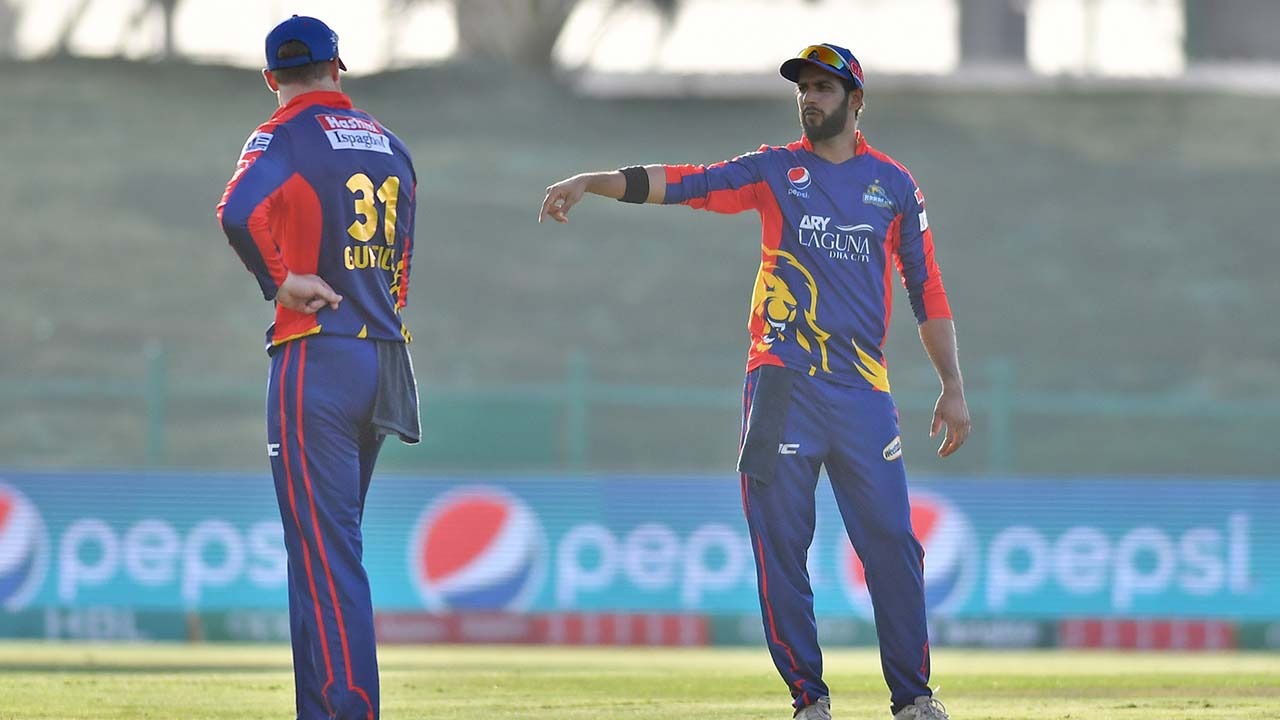Karachi Kings’ captain Imad Wasim outlined two major reasons after his team failed to defend 190 against Islamabad United in the PSL match tonight. One: dropped catches and two: they were 15-20 runs short.
While we know the importance of dropped catches, let’s discuss the second factor in detail.
Almost every time we see a team losing after batting first, we hear its captain saying the cliche that they were 10-20 runs short. We barely see captains in the T20s saying they lost because they were bowled out.
In the T20s, teams often fall short of competitive totals because of unnecessarily worrying about wickets. And that’s exactly the mistake Karachi batsmen made during the middle phase of their batting against Islamabad.
An innings that could have been 200 or 210 was finished at 190-4 in 20 overs.
Karachi were 56-1 in the Powerplay but in the next six overs, they added only 35 runs and lost one wicket. Two of those overs were bowled by Iftikhar Ahmed which means they just didn’t take the risk even against a part-timer despite having eight wickets in hand.
A case of not maximizing resources
Babar Azam was 26 off 18 at the end of Powerplay but in the next six overs, he scored only 16 off 16 balls. Najeeb Zadran (13 off 17 balls) was unimpressive too but he had mitigating circumstances that he was new on the crease.
Babar is an immensely improved batsman in all three formats – in Tests he has taken his career average from 23 to 42, in ODIs the strike rate that used to be in the 80s is now in the 90s and in the last couple of years, his T20I strike-rate has hovered around 140.
But one area where he still needs some work is setting up targets.
In this PSL, Babar scored 90 off 60 balls to chase 196 against Multan in Karachi and then knocked 77 off 47 balls to scale 189 against Peshawar. But his both 50plus scores while batting first have come in losing causes – 81 off 54 balls and 62 off 54 balls against Islamabad in Abu Dhabi and Karachi respectively.
This is absolutely NOT to say that Karachi is losing due to his innings. This is only to highlight the point that when you are chasing you know what strike rate will be sufficient but when you are batting first you don’t know how much is enough.
That’s why batsmen need to accelerate early in the innings when they are setting targets. Babar shifted gears only in the 15th over and from that point scored 35 off 15 balls at an incredible strike rate of 233.33.
A strike rate of 233 shows he has the prowess to bat at a brisk pace but he puts it to practice very late in the innings. Had he pushed the accelerator couple of overs early, the final total could have been 210ish instead of 190.
Even if he had gotten out in that process, it would have provided Karachi’s power-batsmen some more resources to bat with. Thisara Perera, Chadwick Walton and Imad are being used by Karachi as their power batsmen but they came to bat when only when nine balls were left.
It is a sheer case of not maximizing your resources.
India made same mistake recently
Virat Kohli, another batting great, was guilty of the same mistake recently. In the third T20I against England in Ahmedabad this year, India scored 69 runs from the last five overs but in the previous five overs, they added only 32 runs.
Kohli’s late acceleration and the fact that the power-hitters didn’t get enough balls meant India put only 156 which was chased by England.
Kohli is a batsman who is more comfortable while chasing again because when you are chasing you know what strike rate to maintain and how to construct innings. That’s why Kohli’s average in chases in T20Is is 83.76 but while batting first it comes down to 35.89.
Learn from New Zealand
New Zealand often give us a template of maximizing resources – no wonder they are number one in Test and ODI Rankings and at third in T20Is. There is an example that I have cited on numerous platforms before.
Devon Conway came to bat at four and scored 99 not off 59 balls in the first T20I against Australia at Hagley Oval earlier this year. But in the next match, when the second wicket fell at 151 in 14.4 overs, they promoted Jimmy Neesham up the order. Neesham then hit 45 off 16 balls and took the total to 219-7 in 20 overs.
Promoting your power batters in the batting order is not something that is uncommon in T20s but the point here is that New Zealand knew a batter, who scored 99 in his previous T20I inns and had 402 runs in his last five T20 innings, was not good enough for this particular situation. Many other teams could have easily been distracted by the form Conway was in.
Even if New Zealand had sent Conway and ended with 200, their batsmen were unlikely to be questioned but with their shrewd planning, they maximized their resources and managed to add some 20 more runs.
The fact that New Zealand won that match by only four runs will further tell us how crucial 10-20 runs can be.
